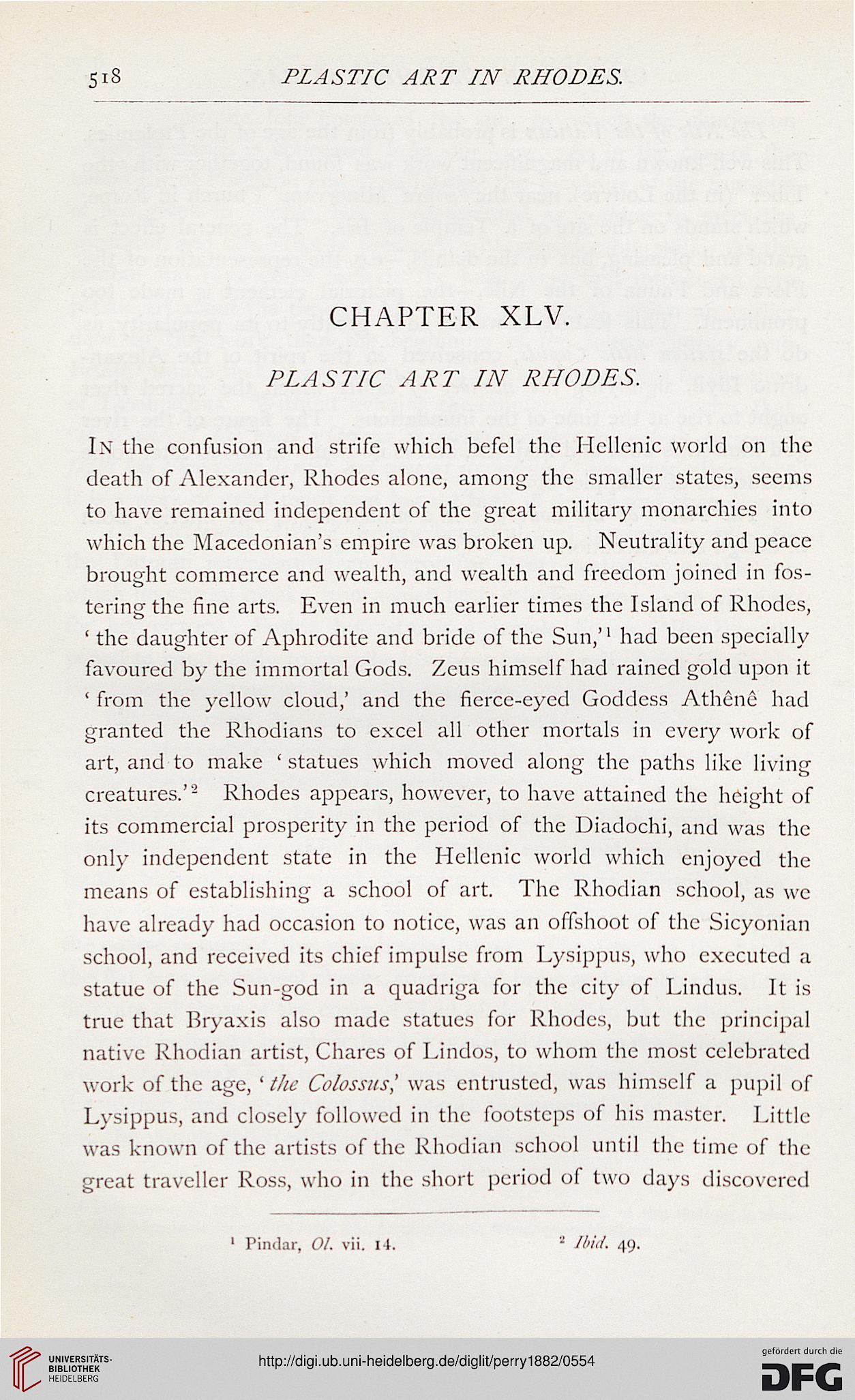5iS
PLASTIC ART IN RHODES.
CHAPTER XLV.
PLASTIC ART IN RHODES.
In the confusion and strife which befcl the Hellenic world on the
death of Alexander, Rhodes alone, among the smaller states, seems
to have remained independent of the great military monarchies into
which the Macedonian's empire was broken up. Neutrality and peace
brought commerce and wealth, and wealth and freedom joined in fos-
tering the fine arts. Even in much earlier times the Island of Rhodes,
' the daughter of Aphrodite and bride of the Sun,'1 had been specially
favoured by the immortal Gods. Zeus himself had rained gold upon it
' from the yellow cloud,' and the ficrcc-cycd Goddess Athene had
granted the Rhodians to excel all other mortals in every work of
art, and to make ' statues w hich moved along the paths like living
creatures."2 Rhodes appears, however, to have attained the height of
its commercial prosperity in the period of the Diadochi, and was the
only independent state in the Hellenic world which enjoyed the
means of establishing a school of art. The Rhodian school, as we
have already had occasion to notice, was an offshoot of the Sicyonian
school, and received its chief impulse from Lysippus, who executed a
statue of the Sun-god in a quadriga for the city of Lindus. It is
true that Bryaxis also made statues for Rhodes, but the principal
native Rhodian artist, Chares of Lindos, to whom the most celebrated
work of the age, 1 the Colossus,' was entrusted, was himself a pupil of
Lysippus, and closely followed in the footsteps of his master. Little
was known of the artists of the Rhodian school until the time of the
great traveller Ross, who in the short period of two days discovered
Pindar, 01. vii. 14.
■ Ibid. 49.
PLASTIC ART IN RHODES.
CHAPTER XLV.
PLASTIC ART IN RHODES.
In the confusion and strife which befcl the Hellenic world on the
death of Alexander, Rhodes alone, among the smaller states, seems
to have remained independent of the great military monarchies into
which the Macedonian's empire was broken up. Neutrality and peace
brought commerce and wealth, and wealth and freedom joined in fos-
tering the fine arts. Even in much earlier times the Island of Rhodes,
' the daughter of Aphrodite and bride of the Sun,'1 had been specially
favoured by the immortal Gods. Zeus himself had rained gold upon it
' from the yellow cloud,' and the ficrcc-cycd Goddess Athene had
granted the Rhodians to excel all other mortals in every work of
art, and to make ' statues w hich moved along the paths like living
creatures."2 Rhodes appears, however, to have attained the height of
its commercial prosperity in the period of the Diadochi, and was the
only independent state in the Hellenic world which enjoyed the
means of establishing a school of art. The Rhodian school, as we
have already had occasion to notice, was an offshoot of the Sicyonian
school, and received its chief impulse from Lysippus, who executed a
statue of the Sun-god in a quadriga for the city of Lindus. It is
true that Bryaxis also made statues for Rhodes, but the principal
native Rhodian artist, Chares of Lindos, to whom the most celebrated
work of the age, 1 the Colossus,' was entrusted, was himself a pupil of
Lysippus, and closely followed in the footsteps of his master. Little
was known of the artists of the Rhodian school until the time of the
great traveller Ross, who in the short period of two days discovered
Pindar, 01. vii. 14.
■ Ibid. 49.




